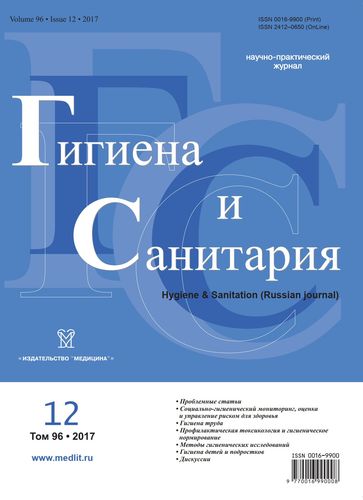Risk-based programme for the prevention of respiratory disease in workers at the titanium and magnesium plant
- 作者: Shlyapnikov D.M.1, Vlasova E.M.1
-
隶属关系:
- Center for Medical and Preventive Health Risk Management Technologies
- 期: 卷 96, 编号 12 (2017)
- 页面: 1171-1175
- 栏目: OCCUPATIONAL HEALTH
- ##submission.datePublished##: 21.10.2020
- URL: https://vestnik.nvsu.ru/0016-9900/article/view/640719
- DOI: https://doi.org/10.47470/0016-9900-2017-96-12-1171-1175
- ID: 640719
如何引用文章
全文:
详细
Working conditions of employees are characterized by concomitant exposure to chlorine and hydrochloride vapors, dust, industrial noise, total vibration, levels of microclimate indices higher than normal ones and the hardness of the labor. They are classified as hazardous: working conditions class 3.3 – 3.4. The combined exposure to PM10 particles (most of the total suspended particles mass), irritants (sulfur dioxide, nitrogen oxide, hydrogen chloride, chlorine) results in the predominance of respiratory diseases in the morbidity pattern in employees (p < 0.05). A strong statistically significant causal relationship was established between the respiratory diseases and the working conditions (RR=2.9 95% CI=1.81-4.64; EF=65.49%). Higher prevalence of upper respiratory airway diseases (chronic rhinitis, nasopharyngitis) was observed (p < 0.05). The development of these diseases was found to depend on the length of employment, no statistically significant prevalence being observed in the control group. The assessment of the respiratory function showed no deviations from the physiological norm both in the study group and the control group, making it difficult to identify diseases of the lower respiratory airways during the routine medical examination. At the same time, diseases of the lower respiratory airways (simple chronic bronchitis; mucopurulent chronic bronchitis) were diagnosed in 25.6% of workers of the study group and 13.7% of workers of the control group (p < 0.05). The changes found during echocardiography, without any impairment of the respiratory function and clinical symptoms at the stage of the routine medical examination, indicate the lower respiratory airway diseases to be latent. For the workers there was proposed the program for the prevention of a risk-based respiratory disease, which involves the division of workers into 4 groups and the development of individual recommendations and program of the prevention for each group.
作者简介
Dmitriy Shlyapnikov
Center for Medical and Preventive Health Risk Management Technologies
编辑信件的主要联系方式.
Email: shlyapnikov@fcrisk.ru
ORCID iD: 0000-0002-3532-3630
MD, PhD, Head of Health Risk Analysis Department of the Center for Medical and Preventive Health Risk Management Technologies, Perm, 614045, Russian Federation.
e-mail: shlyapnikov@fcrisk.ru
俄罗斯联邦E. Vlasova
Center for Medical and Preventive Health Risk Management Technologies
Email: noemail@neicon.ru
ORCID iD: 0000-0003-3344-3361
俄罗斯联邦
参考
- Roslaya N.A., Fomin I.N., Likhacheva E.I., Roslyy O.F., Tetyukhin V.V. Occupational medicine in the production of titanium alloys. In: Hygiene: Past, Present, Future: Scientific works of the Federal Scientific Center for Hygiene. F.F. Erisman. Issue 1 [Gigiena: proshloe, nastoyashchee, budushchee: Nauchnye trudy Federal’nogo nauchnogo tsentra gigieny im. F.F. Erismana. Vypusk 1]. Moscow; 2001: 364–6. (in Russian)
- Nosov A.E., Vlasova E.M., Novoselov V.G., Perevalov A.Ya., Ukhabov V.M., Agafonov A.V. Forecasting a risk of occupationally related diseases in workers engaged into titanium-magnesium production. Meditsina truda i promyshlennaya ekologiya. 2016; (8): 10–5. (in Russian)
- State Report «On the state of sanitary and epidemiological wellbeing of the population in the Russian Federation in 2016». Moscow; 2017. (in Russian)
- Bazarova E.L., Osherov I.S., Babenko A.G., Roslyy O.F., Tartakovskaya L.Ya., Roslaya N.A. The impact of hazardous occupational factors on morbidity of workers manufacturing titanium alloys. Meditsina truda i ekologiya cheloveka. 2015; (4): 36–43. (in Russian)
- Velichkovskiy B.T. Pathogenesis of occupational pulmonary diseases caused by dust. Meditsina truda i promyshlennaya ekologiya. 1994; (5-6): 1–8.
- At’kov O.Yu., ed. Ultrasound Examination of the Heart and Blood Vessels [Ul’trazvukovoe issledovanie serdtsa i sosudov]. Moscow: Eksmo; 2015. (in Russian)
- Glantz S.A. Primer of Biostatistics. New-York: McGraw-Hill; 1994.
- Fletcher R.H., Fletcher S.W., Wagner E.H. Clinical Epidemiology: The Essentials. Baltimore: Williams and Wilkins; 1996.
补充文件







